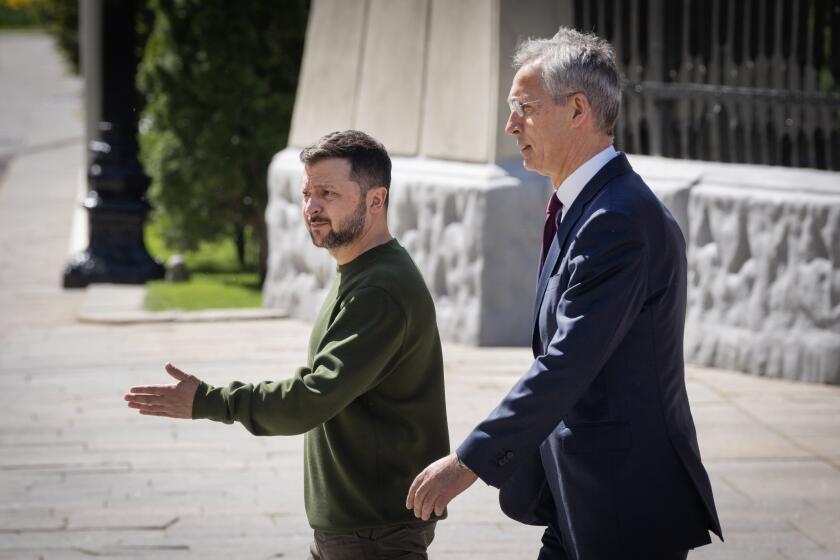Maya, in miniature
My obsession with clay Jaina figures started about a year ago at the Museo de la Cultura Maya in Chetumal, Mexico. That is where I set my eyes on the tiny statues of a Maya woman wearing an elaborate blouse and ear spools and a young warrior with facial tattoos and scars.
The 6- to 7-inch-tall figures -- depictions of ancient Maya in traditional dress -- looked so lifelike that I half expected them to speak. When a museum guide told me that the statues behind glass were replicas of statuettes unearthed at Jaina, the Maya island of the dead off the western Yucatan Peninsula, I was determined to learn more about the figures.
The delicately detailed terra-cotta statuettes, described by experts as the finest figurine art of ancient America, were buried with each deceased person on the island, as many as 10,000 in all.
Pursuing my obsession, I headed to Ticul, a pre-Columbian Maya town about 50 miles south of Merida that’s known for its red-earth pottery, where I was told the replicas of the Jaina figures were being made.
In the area around Ticul’s central plaza, I saw ceramic statues of ancient Maya figures, some about 9 feet high. In front of a colonial church, a sculpture of two white hands cradled a pot. Although local shops sold everything from tchotchkes to fine art pieces, no one could tell me where to find the replica figures.
Just as I was about to give up, I found a gallery called Arte Maya, where I met the man who made the statues near the town’s center. Andres Mena Sanchez had also been making Jaina replicas for 20 years. He explained that Jaina is a man-made island on the western side of the Yucatan that became a necropolis because the Maya associated the west with death.
Inside his gallery, my pulse quickened as Mena Sanchez showed me the small replicas: a statue of a woman giving birth, a ball player, a shaman with a deer headdress, a weaver, a priest figure with only one arm. Some of the terra-cotta sculptures were painted, others not.
Mena Sanchez found pictures of them in archaeology books and created molds. Some figures were formed by hand, and others were a combination of molds and free-form. It was a technique used by the ancient Maya who made the original Jaina figures.
I bought the one-armed priest for $22. But I was not satisfied with owning a replica. I wanted to see the real thing. I contacted sources in Campeche and got permission to visit Jaina with a guide.
The drive to Jaina was over bumpy roads, bordered by dense jungle, teeming with ibises, cranes, flamingos and bright yellow butterflies.
Along the way, my guide, Erik Mendicuti Polanco, explained the history of Jaina.
“A French explorer named Desire Charnay came to Jaina in the late 1800s,” he said. “He found the burial mounds and figurines. The island was protected by the navy to keep people from coming and taking the statues. In 1957 and 1964, excavations were done by INHA [the National Institute of Anthropology and History]. They uncovered two building complexes on the island.”
Archaeologists think some, or even many of the small statues were produced elsewhere on the southern coast of Campeche and in Tabasco state, and brought to Jaina for burial. Or perhaps the clay came from elsewhere, and the figures were made on the island.
Most interments took place between AD 300 and 900, with some of the dead buried inside large pots or vases.
On the road to Jaina, the jungle faded and we passed petrified forests and large expanses of salty fields. When the road ended, we walked about 300 feet across a rickety wood plank bridge that connected the mainland to the tiny island. Then we came to a rocky path, lined with red and deep brown pottery shards. Was I walking over pieces of ancient burial urns?
Suddenly, the ancient town of Jaina emerged on my left. Mendicuti Polanco walked me by Zayosal, the site of the main ceremonial plaza: two pyramids, a ball court, a 5-foot-tall stele carved with the image of a kneeling man, probably a prisoner, his arms tied behind his back.
“They found tombs and figurines where we are now standing, as well as everywhere on the island,” he said. “Ancestors were buried under the platforms of the houses. There were no actual tombs. They also found domestic pottery, grinding bowls and stone hammers that were proof of daily life here. That’s how we know it wasn’t just a necropolis. It was a living island.”
On the other side of the island was a thatched hut, built to protect several stelae incised with tantalizing hints of Jaina’s past.
But no Jaina figures. I would have to drive back to Hecelchakan, near the northern end of Campeche, to see authentic statues.
We drove back along the same road, and about 75 minutes later, we saw a gaggle of tricycle taxis, pastel-colored facades of shops and colonial houses, a plaza with huge topiary birds, and the yellow and white Museo de Hecelchakan.
I walked slowly through the museum, gazing at the little clay people behind glass. A dignified man wore a huge bird headdress; maybe a vulture or a macaw. A seated woman was dressed in a huipil (blouse) and a thick necklace made of beads or shells. A ballplayer with his hair in a mohawk wore a yoke around his waist, which was used for hitting the ball. A woman carried an old man on her back. A seated man held a large pot.
Some of the figures were articulated, like dolls, so their limbs could move. Others had several small holes in them and were designed as whistles. Then came the animals: jaguars, turtles, armadillos, parrots, an owl face with a human body.
The final cases displayed ahaus -- the lords of the ancient Maya world. One had a deeply scarred face and sported ear plugs. A second looked like a samurai in a cape, his arms spread out, claiming his space. Some of them had removable headdresses. They exuded life, energy and unmistakable power.
Mendicuti Polanco told me that the Campeche Museum of Archaeology also displayed Jaina figures, so we headed there. The museum is inside Ft. San Miguel, which the Spanish built in 1801 to defend themselves from the British. It houses one of the most complete collections of Maya art in Mexico.
“Jaina was a cemetery for the whole region,” Marco Antonio Carvajal Correa, the director of museums of INHA Campeche, told me later. “Judging from the figurines of important lords and soldiers, and from recent studies of dental morphology of the deceased, we know that chiefs from Campeche and elsewhere in the Yucatan Peninsula were buried there.”
Many of the statues depict the gods of the sky and the underworld. Ixchel, the maternal goddess, who is identified with the moon and fertility, was often buried with the dead. Perhaps people came to Jaina on pilgrimages to worship Ixchel, or for sacred divinations.
The area was occupied by successive civilizations over the centuries, and the statues show cultural and artistic connections to Teotihuacan near Mexico City, Veracruz plus elsewhere in the Yucatan. The colors used on the figures include red, yellow, coffee, orange, gray and, of course, Maya blue.
Once in the museum, I gazed at ornate statues, masks, stone heads, ceramics, stelae and other artifacts, until I came to the Jaina room. Once more, I was surrounded by the original funerary figurines.
The room had huge burial pots from Jaina, with the bones of the dead still in them. The pots were the colors of the shards I had walked upon on the island. There were more articulated figures.
The statue of a large woman with ample breasts, the trim of her terra-cotta dress a celestial Maya blue, looked out from behind a glass case. Near her, another woman sported a witch-like hat, and a man sat calmly, his body draped with a huge headdress, necklace and bracelets. His body was pierced by two holes so that he could be used as a whistle.
Instead of extensive written records, the people of Jaina let their figurines and other artifacts tell their story.
--
--
BEGIN TEXT OF INFOBOX
If you go
THE BEST WAY TO JAINA
From LAX, connecting service (change of planes) to Campeche is available on Aeromexico and Mexicana. Restricted round-trip fares begin at $630.
To arrange a visit to Jaina, write in English to Luis Fernando Alvarez, Director of INHA, No. 43 Calle 59 (entre 14 y l6), Centro Historico, Campeche, Mexico, 24000; 011-52-981-816-9111. Requests should be made at least several weeks in advance.
WHAT TO SEE
Arte Maya, 269 23rd St., Ticul.
WHERE TO STAY
Del Mar Hotel, 51 Avenida Ruiz Cortinez, Campeche, Campeche; 011-52- 981-811-9191 www.delmarhotel.com.mx. Doubles from about $70.
GUIDE
Erik Mendicuti Polanco, guide: His services cost $100 a day. Car and driver are extra. 011-52-981-81-587-85 or 011-52-981-12-108-92, tgemendicuti@prodigy.net.mx or emobile2@hotmail.com.
More to Read
Start your day right
Sign up for Essential California for news, features and recommendations from the L.A. Times and beyond in your inbox six days a week.
You may occasionally receive promotional content from the Los Angeles Times.






